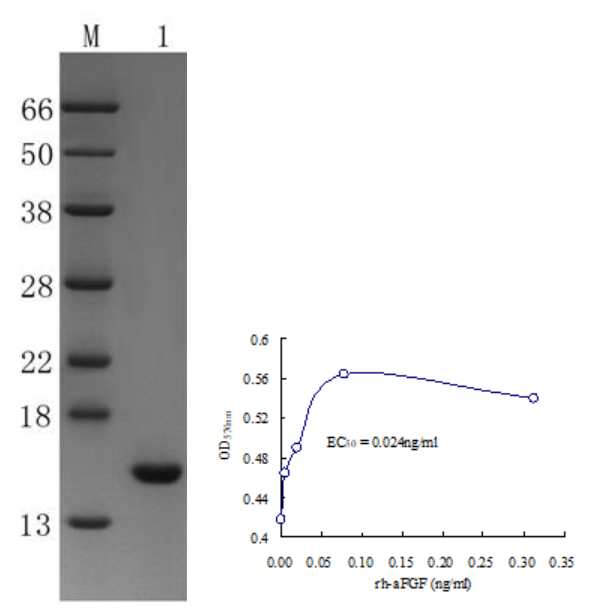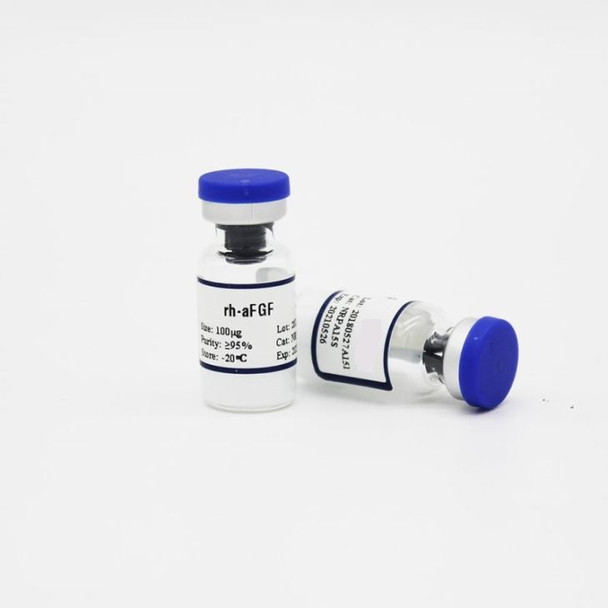Recombinant Human Fibroblast Growth Factor-acidic (rh-aFGF)
- SKU:
- GEN-NRPA15S
- Formulation:
- Lyophilized from 10mM PBS (1mM Na2HPO4, 9mM NaH2PO4, 150mM NaCl, pH 6.0)
- Mol. Weight:
- 16.0 kDa
- Theory pI:
- 7.73
- Resources:
- Escherichia coli (E. coli)
- Species:
- human
- Purity:
- ≥95% by SDS-PAGE analysis
- Storage condition:
- -20 °C
- Storage period:
- 3 years
Description
A fibroblast-acid growth factor, aFGF is a protein which in humans is encoded by the FGF1 gene. The protein encoded by this gene is a member of the fibroblast growth factor (FGF) family. Acidic FGF is a potent growth factor for fibroblasts and endothelial cells. Acidic FGF is involved in wound repair, angiogenesis, and development. Acidic FGF is secreted by cells via a mechanism independent of the endoplasmic reticulum / Golgi. The ability of acidic FGF to bind to heparin sulfate is required for its ability to interact with FGF receptors and induce signaling. There are four distinct FGF receptors and each has several splice variants. Acidic FGF binds with high affinity to many FGFRs, but not all. Signaling cascades activated by the basic binding of FGF to FGFR include the ras-raf-MAPK, PLCy / PKC and PI3K / Akt pathways.
Biological activity: The EC50, calculated by the dose-dependent proliferation of mouse BALB / c 3T3 cells is less than 0.5 ng / ml, corresponding to a specific activity ≥ 2 × 106 units / mg of protein.
Packaging : In general, recombinant proteins are supplied as a lyophilized powder which is shipped at room temperature.
Application : This material is offered by Shanghai PrimeGene Bio-Tech for research, laboratory or other evaluation purposes. NOT FOR HUMAN USE.
GG stability amplifier; storage conditions:
Use a manual defrost freezer No loss of activity has been observed after storage at:
4-8 ° C for 12 months in the lyophilized state;
-70 ° C for 3 months under sterile conditions after reconstitution.

M : Standard protein marker rh-aFGF Stimulate BALB / c 3T3 Cell proliferation test
Track 1 : rh-aFGF
For research only!
Recombinant Human Fibroblast Growth Factor-acidic (rh-aFGF) DataSheet
Advancing frontiers :
Proteoglycan / glycosaminoglycan and collagen content in the arterial wall of patients with end stage renal disease - new indicators of vascular disease
Author: Batko Krzysztof K, Krzanowski Marcin M, Gajda Mariusz M, Dumnicka Paulina P, Pietrzycka Agata A, Fedak Danuta D, Woziwodzka Karolina K, Gołasa Paulina P, Kuźniewski Marek M
Journal: 2019-10-15 DOI: 10.1002 / smll.201802403
Summary: + Cardiovascular (CV) comorbidity is high in chronic kidney disease, particularly in end-stage renal disease (ESRD).
Rifampicin, not vitamin E, suppresses the development of liver diseases associated with parenteral nutrition via the Pregnane X receptor pathway in piglets
Author: Guthrie Gregory G, Stoll Barbara B, Chacko Shaji S, Lauridsen Charlotte C, Plat Jogchum J
Journal: Am. J. Physiol. Gastrointest. Physiol of the liver. 10/11/2019 DOI: 10.1002 / smll.201802403
Summary: + Infants receiving long-term parenteral nutrition (PN) develop PN-associated liver disease (PNALD).
The probiotic LGG prevents liver fibrosis by inhibiting hepatic bile acid synthesis and increasing bile acid excretion in mice
Author: Liu Yunhuan Y, Chen Kefei K, Li Fengyuan F, Gu Zelin Z, Liu Qi Q, He Liqing L, Shao Tuo T, Song Qing Q, Zhu Fenxia F
Journal: Hepatology 2019-09-30 DOI: 10.1002 / smll.201802403
Summary: + Cholestatic liver disease is characterized by intestinal dysbiosis and excessive toxic hepatic bile acids (BA).






